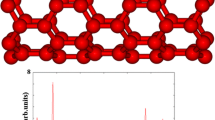Abstract
Carbon single-walled nanotubes (SWNTs) have been studied extensively as hydrogen storage materials. Herein, a novel hydrogen sorbtion behavior was observed for alkali metal reduced SWNTs and the mechanism of hydrogen binding in these materials has now been elucidated. SWNTs prepared by laser vaporization and purified by oxidation were reduced with Na in combination with naphthalene in tetrahydrofuran (THF) solution. The product, initially formulated as (Na+)xSWNTx-, was dark colored and insoluble in all common solvents examined. Temperature programmed desorption studies showed that hydrogen amounting to 3.5-4.2% w/w was released between 200 and 500°C from the Na-reduced material. This is consistent with hydrogenation of the reduced nanotubes to form C-H bonds with a C2H empirical formula. It appears that SWNT radical anions produced by reaction with sodium deprotonate THF to form hydrogenated nanotubes and the THF cleavage products ethylene and sodium enolate, as confirmed by isotope labeling. A structure consisting of pairs of lines of C-H units that spiral about the long tube axis with a coverage of 50% of the tube carbons is proposed.
Similar content being viewed by others
References
Iijima, S. and T. Ichihashi, Nature, 363(6430), 603–605 (1993).
Tomanek, D., A. Jorio, M.S. Dresselhaus, and G. Dresselhaus, Carbon Nanotubes, 111, 1–12 (2008).
Dillon, A.C., K.M. Jones, T.A. Bekkedahl, C.H. Kiang, D.S. Bethune, and M.J. Heben, Nature, 386(6623), 377–379 (1997).
Penicaud, A., P. Poulin, A. Derre, E. Anglaret, and P. Petit, J. Am. Chem. Soc., 127(1), 8–9 (2005).
Dillon, A.C., T. Gennett, K.M. Jones, J.L. Alleman, P.A. Parilla, and M.J. Heben, Advanced Materials, 11(16), 1354–1358 (1999).
Pekker, S., J.P. Salvetat, E. Jakab, J.M. Bonard, and L. Forro, J. Phys. Chem. B, 105(33), 7938–7943 (2001).
Bates, R.B., D.E. Potter, and L.M. Kroposki, J. Org. Chem., 37(4), 560 (1972).
Miller, G.P., J. Kintigh, E. Kim, P.F. Weck, S. Berber, and D. Tomanek, J. Am. Chem. Soc., 130(7), 2296–2303 (2008).
Bauschlicher, C.W., Nano Letters, 1(5), 223–226 (2001).
Konig, E., H. Musso, and U.-I. Zahorszki, Angew. Chem. Internat. Edit., 11, 45–46 (1972).
Author information
Authors and Affiliations
Rights and permissions
About this article
Cite this article
Curtis, C.J., Gennett, T., Engtrakul, C. et al. Mechanism of Hydrogen Storage on Reduced Carbon Single-Walled Nanotubes. MRS Online Proceedings Library 1098, 10980404 (2008). https://doi.org/10.1557/PROC-1098-HH04-04
Received:
Accepted:
Published:
DOI: https://doi.org/10.1557/PROC-1098-HH04-04



